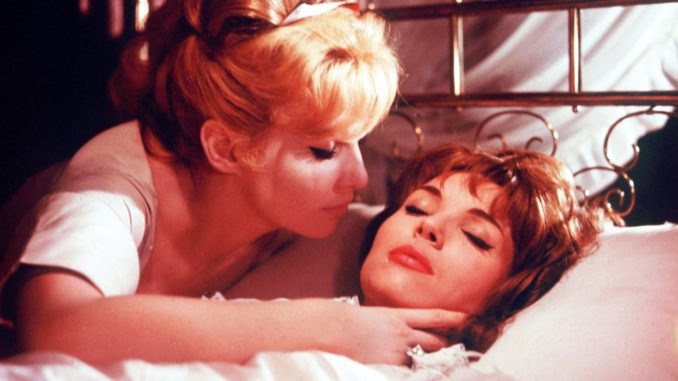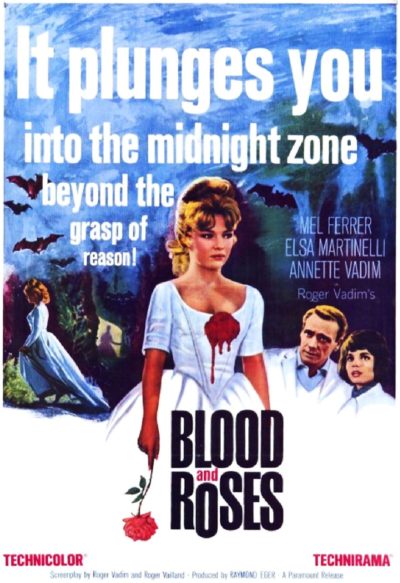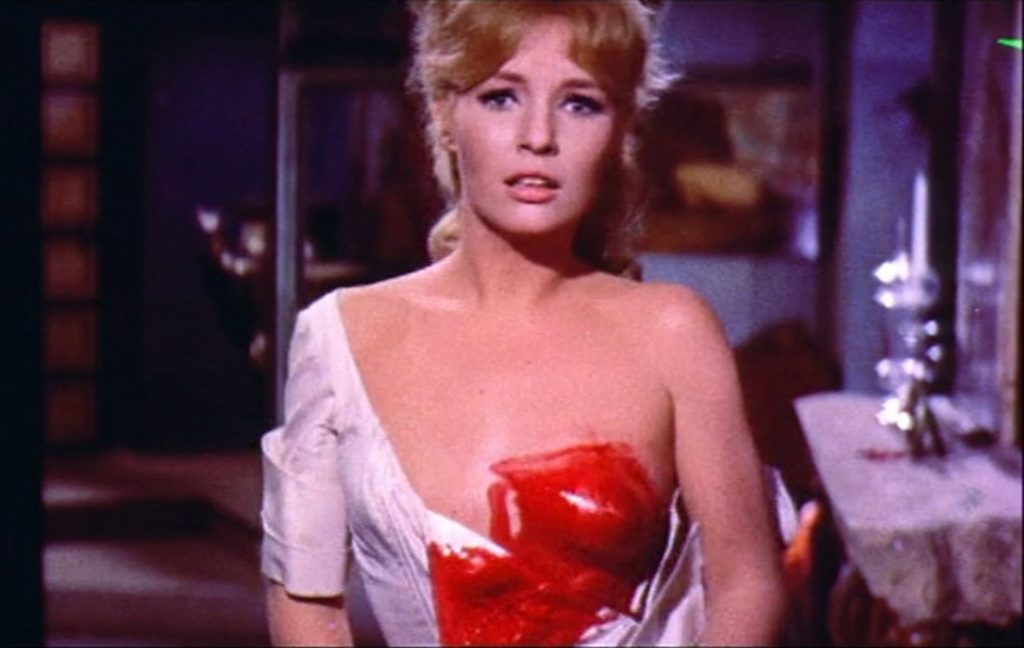
Rating: C+
Dir: Roger Vadim
Star: Annette Stroyberg, Mel Ferrer, Elsa Martinelli, René-Jean Chauffard
a.k.a. Et mourir de plaisir
Bram Stoker’s Dracula is, understandably, regarded as the Patient Zero of vampires and vampire films. It is, potentially, the book most frequently adapted into a horror movie. [Whether it or Mary Shelley’s Frankenstein come out on top, would likely depend on the precise boundaries by which an adaptation counted] But it was far from the first vampire story. More than a generation before Stoker, Irish writer Sheridan Le Fanu had written the novella Carmilla, about a female vampire by that name, who is the current identity of the immortal Mircalla, Countess Karnstein. Published in 1872, and thus pre-dating Dracula by 25 years, it established the lesbian vampire, albeit in a subtle, generally understated way, which is understandable given Le Fanu’s era.
Like Dracula, it has been adapted, with varying degrees of accuracy, on a number of occasions. Carl Dreyer’s Vampyr, and Dracula’s Daughter, both draw some inspiration from the story, and Hammer’s The Vampire Lovers is a fairly faithful version; certainly more so than the other entries in their “Karnstein trilogy”. But a decade before that, Vadim’s version is generally considered to be the first genuine adaptation, particularly in the way it addressed the lesbian elements. This feels somewhat daring for the time, and due to the mature content, suffered cuts for its initial American release, coming in at 74 minutes. It remains difficult to obtain today, with the closest to a proper release being a German DVD with poor audio, which frequently sounds like someone is frying bacon, just off-camera.
 The plot is wrapped around, as a story told on an airplane by Dr. Verari (Chauffard) to his fellow passengers, an accounting of an experience he had previously. This took place in central Italy, where noble landowner Leopoldo De Karnstein (Ferrer) is heading towards marriage to Georgia Monteverdi (Martinelli). At the estate for the celebrations is his Austrian cousin, Carmilla Karnstein (Stroyberg – at the time Annette Vadim, being married to the film’s director). There’s some family history here: back in the 18th century, her ancestors were all but wiped out by the locals for their supposed vampirism, with only Mircalla Karnstein escaping their wrath, being buried in a secret tomb somewhere on the grounds.
The plot is wrapped around, as a story told on an airplane by Dr. Verari (Chauffard) to his fellow passengers, an accounting of an experience he had previously. This took place in central Italy, where noble landowner Leopoldo De Karnstein (Ferrer) is heading towards marriage to Georgia Monteverdi (Martinelli). At the estate for the celebrations is his Austrian cousin, Carmilla Karnstein (Stroyberg – at the time Annette Vadim, being married to the film’s director). There’s some family history here: back in the 18th century, her ancestors were all but wiped out by the locals for their supposed vampirism, with only Mircalla Karnstein escaping their wrath, being buried in a secret tomb somewhere on the grounds.
As part of the celebrations for the impending nuptials, a fireworks display takes place, but this sets off a forgotten piece of World War II ordnance, which uncovers the entrance to the tomb. Carmilla finds it and… Well, this is where things become a little vague. Like George A. Romero’s Martin, we’re never quite sure if Carmilla is a genuine vampire, having been turned by her immortal ancestor, or if she’s simply mentally disturbed. Either way, her doubts about the marriage come to the forefront, with Carmilla apparently attracted to both the groom- and bride-to-be. A servant in the house also goes missing, and when her corpse turns up with bite-like marks on her neck, the chatter around the village increases. Especially among those who are familiar with the Karnstein’s family history.
The main thing this has going for is some wonderful cinematography by Claude Renoir. He would go on to be director of photography on Barbarella (starring another Mrs. Roger Vadim, Jane Fonda) and, somewhat bizarrely, was also the cinematographer on The Spy Who Loved Me. Here, he does an excellent job of walking the line between reality and fantasy, particularly in the sequence where Carmilla enters her ancestor’s crypt, wearing a dress passed down through the generations. Every shot looks like it was composed by one of the Old Masters. There’s also a surreal dream sequence, largely cut for the overseas release, which switches between black and white, colour, and black and white with color, to jarring yet undeniably memorable effect.
Proceedings are also helped by being partly filmed on location at Hadrian’s Villa on the outskirts of Rome. Now a UNESCO World Heritage Site, it adds the kind of production value you can’t get from sets, steeping the whole story in almost two thousand years of history. On the other hand, the whole thing is likely too damn chaste for its own good, by modern standards. While almost ninety years may have passed since Le Fanu’s story, Vadim is still able only to hint at the lesbian elements, with a touch of finger-sucking about as close as it comes to hot girl-on-girl action, and the briefest of brief flashes of nudity, when Carmilla rips off her apparently blood-stained top (below). The results are less restrained, than chained up and tossed into the cellar of conventional morality.
 Just as I prefer the remake of Cat People for its ability to address the sexual elephant in the room directly, so I find The Vampire Lovers more honest. What a difference a decade makes, in terms of censorship. My other problem is the performances here, which are simply not very interesting. I can see why Vadim married her, let’s be honest. Yet as with another Mrs. Vadim, Brigitte Bardot, questions have to be asked about her ability to do much more than be pretty and, on occasion, move carefully from point A to point B. This is not out of line with some of the Hammer films, whose EuroTotty actresses were often employed on the basis of their looks, to wildly variable result. [Ingrid Pitt = good; Yutte Stensgaard… not so much]
Just as I prefer the remake of Cat People for its ability to address the sexual elephant in the room directly, so I find The Vampire Lovers more honest. What a difference a decade makes, in terms of censorship. My other problem is the performances here, which are simply not very interesting. I can see why Vadim married her, let’s be honest. Yet as with another Mrs. Vadim, Brigitte Bardot, questions have to be asked about her ability to do much more than be pretty and, on occasion, move carefully from point A to point B. This is not out of line with some of the Hammer films, whose EuroTotty actresses were often employed on the basis of their looks, to wildly variable result. [Ingrid Pitt = good; Yutte Stensgaard… not so much]
There are some interesting twists on the usual vampire lore, such as the way Carmilla’s horse is suddenly afraid of her, post-transformation, or how it’s reported that merely holding a clove of garlic is enough to repel vampires. None of this really goes anywhere, however, much like the lesbian subtext which leans heavily on the “sub”. It’s a film which looks lovely, yet seems in severe need of demonstrating a greater degree of commitment to its content. Is Carmilla a vampire? Is she a lesbian? There can be such a thing as too much subtlety, and this shows you what happens, in such a circumstance.
This review is part of our October 2023 feature, 31 Days of Vampires.
